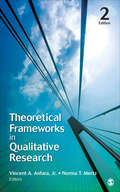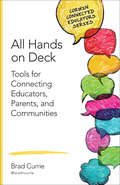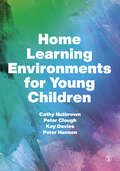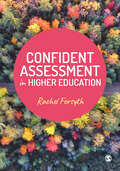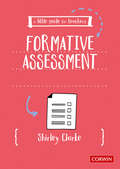- Table View
- List View
Conducting Research in Psychology: Measuring the Weight of Smoke
by Brett W. Pelham Hart C. BlantonConducting Research in Psychology: Measuring the Weight of Smoke provides students an engaging introduction to psychological research by employing humor, stories, and hands-on activities. Through its methodology exercises, learners are encouraged to use their intuition to understand research methods and apply basic research principles to novel problems. Authors Brett W. Pelham and Hart Blanton integrate cutting-edge topics, including implicit biases, measurement controversies, online data collection, and new tools for determining the replicability of a set of research findings. The Fifth Edition broadens its coverage of methodologies to reflect the types of research now conducted by psychologists. Two new chapters accommodate the needs of instructors who incorporate student research projects into their courses.
Transit Recovery in the Aftermath of Severe Weather Events: Current State of Practice
by Transportation Research Board National Academies of Sciences, Engineering, and Medicine Transit Cooperative Research Program Patricia Bye Deborah MatherlySevere weather events can impact transit agency operations, equipment, and infrastructure. For example, Hurricane Katrina in 2005 destroyed the transit fleet of the New Orleans Regional Transit Authority, more than 300 buses. In another example, an EF-4 tornado in 2021 destroyed the fleet of the Fulton County Transit Authority in Kentucky. TCRP Synthesis 180: Transit Recovery in the Aftermath of Severe Weather Events: Current State of Practice, from TRB’s Transit Cooperative Research Program, documents the current state of practice around transit recovery plans and provides examples of short- and long-term recovery. The focus is on bus operations in U.S. passenger public transportation systems, recognizing also that transit agencies may offer multiple types of services in addition to bus services, such as rail and light rail, streetcars or trolleys, paratransit, and ferry service.
A Guide to Applying the Safe System Approach to Transportation Planning, Design, and Operations
by Transportation Research Board National Academies of Sciences, Engineering, and Medicine National Cooperative Highway Research Program Kendra Schenk Alan Dellapenna Timothy E. Barnett Narayan Donaldson Nick Falbo Jeremy VanVleet Tabitha Combs Jonathon Weisenfeld Laura Sandt Katherine Harmon Wesley Kumfer Daniel Gelinne Seth LaJeunesseThe Safe System approach is a holistic approach that provides a framework for making the U.S. national transportation system safer. It is based on building and reinforcing multiple layers of protection to prevent crashes from happening and minimize the harm caused when crashes occur. This safety approach differs from conventional ones because it focuses on human vulnerability and creates a system with many redundancies to protect all transportation users. NCHRP Research Report 1135: A Guide to Applying the Safe System Approach to Transportation Planning, Design, and Operations, from TRB’s National Cooperative Highway Research Program, presents information for applying the Safe System approach among state departments of transportation and other transportation agencies. Supplemental to the report is NCHRP Web-Only Document 413: Applying the Safe System Approach to Transportation Planning, Design, and Operations.
The Future of Commuter Rail in North America
by Transportation Research Board National Academies of Sciences, Engineering, and Medicine Transit Cooperative Research Program Paul Lewis Leo ShirkyCommuter rail services operate in more than 20 North American regions, connecting communities to urban downtowns. These services enjoyed decades of growth, with ridership increasing by 50 percent between 1990 and 2019. However, travel demand shifts brought on by the COVID-19 pandemic and continued work-from-home patterns caused ridership to collapse and only partially recover. This sudden change also upended the traditional financial model, in which fare revenues covered more than half of operating costs. While commuter rail providers vary in size and structure, they all share an uncertain future in solidifying a long-term and financially sustainable role in serving regional transportation demands. TCRP Research Report 254: The Future of Commuter Rail in North America, from TRB’s Transit Cooperative Research Program, examines the history of commuter rail in North America, evaluates current trends, presents constraints, reviews case studies, and explores strategies—including alternative approaches to service schedules, simplified fare structures, and infrastructure options—to address changing goals and circumstances at the agency, regional, and national levels in the United States and Canada.
Risk Management at State DOTs: Building Momentum and Sustaining the Practice
by Transportation Research Board National Academies of Sciences, Engineering, and Medicine National Cooperative Highway Research Program Cambridge Systematics Jacobs Engineering Group Inc.The transportation industry continues to face a range of unforeseen and evolving challenges to transportation assets and operations that affect the performance and resilience of transportation systems and networks. For example, significant disruptions to supply chains and traffic patterns were outcomes of the unanticipated collapse of the Key Bridge in Baltimore, Maryland. NCHRP Research Report 1146: Risk Management at State DOTs: Building Momentum and Sustaining the Practice, from TRB’s National Cooperative Highway Research Program, provides guidelines for state departments of transportation and other agencies to establish and maintain a risk management culture and practice.
Newborn Screening in the United States: A Vision for Sustaining and Advancing Excellence
by Board on Children, Youth, and Families Board on Health Sciences Policy National Academies of Sciences, Engineering, and Medicine Health and Medicine Division Committee on Newborn Screening: Current Landscape and Future DirectionsFor over 60 years, public health newborn screening programs have served families in the United States by identifying babies at risk of serious but treatable conditions and connecting them to clinical care. Today, more than 98% of infants receive dried blood spot screening, which entails collecting a few drops of blood during the first days of life, applying them to a paper card, and sending the card to a lab to be tested for markers of specific health conditions like congenital hypothyroidism, cystic fibrosis, and sickle cell disease. The public health impacts of newborn screening are vast, with over 7,000 infants identified annually for timely interventions. Despite these achievements, challenges in implementing newborn screening programs persist. In response to a congressional request, the Office on Women’s Health of the U.S. Department of Health and Human Services asked the National Academies to convene an ad hoc committee of subject matter experts to examine the current landscape of newborn screening in the United States, recommend options to strengthen this public health service, and establish a vision for the future. Supplementary funding was provided by the Chan Zuckerberg Initiative to enable additional public engagement. The resulting report provides actionable recommendations for navigating the path ahead while preserving and enhancing what is already considered a valuable and effective public health achievement.
Digital Model-Based Project Development and Delivery: A Guide for Quality Management
by John Reese Transportation Research Board National Academies of Sciences, Engineering, and Medicine National Cooperative Highway Research Program Hala Nassereddine Rachel Catchings Marcia Yockey Francesca Maier Jennifer Steen Alexa MitchellState departments of transportation (DOTs) have begun changing the medium of construction contract documents from paper or 2D plans to 3D models that are contractually binding. The driver of this major change is the ability for contractors and inspectors to use 3D models directly to support project activities and communicate the design intent. However, changing the medium of construction contract documents has created challenges for state DOTs, including a need for robust review and documentation procedures as well as a lack of automated quality control and quality assurance management processes for 3D models. NCHRP Research Report 1153: Digital Model?Based Project Development and Delivery: A Guide for Quality Management, from TRB?s National Cooperative Highway Research Program, presents state-of-the-art information to assist state DOTs in their review of 3D models that are contractually binding and to advance the use of digital project development and delivery. Supplemental to the report are NCHRP Web-Only Document 428: Quality Management for Digital Model?Based Project Development and Delivery, Appendix F Addendum: Review Checklist Spreadsheet, an implementation plan, and a webinar presentation.
Snapshots of Planning Practices
by Transportation Research Board National Academies of Sciences, Engineering, and Medicine National Cooperative Highway Research Program Tanisha Hall Ron Basile Leah Pickett Rachel Vierstra John Kaliski Melanie BakerNCHRP Web-Only Document 431: Snapshots of Planning Practices, from TRB’s National Cooperative Highway Research Program, presents a series of illustrated “snapshots” that serve as a resource for transportation-planning practice development and provide information for realistic practice implementation and program advancement. The document is supplemental to NCHRP Research Report 1158: Developing Snapshots for Transportation Planning.
Planning for 4.9 GHz Spectrum Changes
by Daphne Miller Transportation Research Board National Academies of Sciences, Engineering, and Medicine National Cooperative Highway Research Program Andrew Maxymillian Alan S. TillesThe Federal Communications Commission’s current licensing freeze, while it considers new rules for the 4.9 GHz spectrum band, leaves a limited number of options for new use of the band. While it is not presently known when the freeze will be lifted, and if any new rules will be put into effect, there are nevertheless currently several potential opportunities for state department of transportation operations in the band. NCHRP Web-Only Document 422: Planning for 4.9 GHz Spectrum Changes, from TRB’s National Cooperative Highway Research Program, provides background and guidance for transportation agencies that wish to implement systems in the band.
Reducing and Managing Disruptive and Unruly Behavior in Airports: A Guide
by Kate Moore Transportation Research Board National Academies of Sciences, Engineering, and Medicine Scott Houston Airport Cooperative Research Program Michael Everson Valerie Walker Danielle Pires Toshia Shavies Marshall Jessica Gafford Michele FreadmanThe number of incidents involving disruptive, threatening, or violent behavior in commercial airports has increased in recent years. However, much of the response to these incidents has been focused on addressing behavior in flight, leaving airport operators with limited guidelines tailored to the airport environment. ACRP Research Report 280: Reducing and Managing Disruptive and Unruly Behavior in Airports: A Guide, from TRB’s Airport Cooperative Research Program, presents a practical guide for reducing and responding to incidents of disruptive, threatening, or violent behavior in an airport setting. The guide examines the topic holistically and offers a structured approach to understanding root causes, prevention and mitigation strategies, coordinated response, and postincident analysis.
Connected Leadership: It’s Just a Click Away (Corwin Connected Educators Series)
by Spike C. CookYou’re at the top—but never alone! Take the leap and connect with other educators and leaders through social media. Educators learn to transform relationships with their students, staff, parents, and with the overall community in this simple guide to social media. With real-life examples from K12 educators who’ve integrated social media technology and education, this guide helps educators to harness the power of connectedness and change the way you lead. Jump in and you’ll learn how to: Develop a personal learning network Tell your school’s story through blogging Use connections to transform your leadership The Corwin Connected Educators series is your key to unlocking the greatest resource available to all educators: other educators. Being a Connected Educator is more than a set of actions: it’s a belief in the potential of technology to fuel lifelong learning. "This book has practical examples of how educators can use Web 2.0 tools to grow professionally and personally. Cook describes his journey as a lead learner in a way that is easy to read; he inspires, engages, and encourages the reader to move from isolation to connection." Dwight Carter, Principal New Albany High School "After reading this book, you′ll be inspired by the stories of newly connected educators. If you′ve been hesitant to take the plunge into the social media waters, you′ll be ready to jump right in after this quick and informative read." Erin Klein, Teacher and Blogger Kleinspiration
Theoretical Frameworks in Qualitative Research
by Vincent A. Anfara Jr. Norma T. MertzThe Second Edition of Theoretical Frameworks in Qualitative Research brings together some of today’s leading qualitative researchers to discuss the frameworks behind their published qualitative studies. They share how they found and chose a theoretical framework, from what discipline the framework was drawn, what the framework posits, and how it influenced their study. Both novice and experienced qualitative researchers are able to learn first-hand from various contributors as they reflect on the process and decisions involved in completing their study. The book also provides background for beginning researchers about the nature of theoretical frameworks and their importance in qualitative research; about differences in perspective about the role of theoretical frameworks; and about how to find and use a theoretical framework.
The Power of Branding: Telling Your School′s Story (Corwin Connected Educators Series)
by Tony Sinanis Joseph M. SanfelippoTurn a spotlight on what’s great about your school! Inform, engage, and support your school community with this step-by-step guide in the Connected Educators Series. Begin exploring the benefits of branding and create an action plan for sharing the excellent things unfolding in your classroom, school, or district. Includes concrete suggestions and in-depth case studies that will help you: Artfully create a brand name, symbol or design Share great events using blogs and more Empower all stakeholders, including students Teach digital citizenship K-12 Use this all-inclusive guide to start sharing just how special your school is! The Corwin Connected Educators series is your key to unlocking the greatest resource available to all educators: other educators. Being a Connected Educator is more than a set of actions: it’s a belief in the potential of technology to fuel lifelong learning. To explore the other books in this series, visit the "Focusing on the positive things happening in schools gives leaders more drive and has a tremendous impact on school culture. This book is a powerful resource for leaders looking to promote the good in their schools." Todd Whitaker, Author of What Great Teachers Do Differently "Tony and Joe not only recognize the significance of branding in education, but they provide an array of examples and strategies that will allow all educators to create a positive brand presence for their schools." Eric Sheninger, Author of Digital Leadership
All Hands on Deck: Tools for Connecting Educators, Parents, and Communities (Corwin Connected Educators Series)
by Brad M. CurrieBring communities together for involvement that makes a difference! Impact your students in a positive way and join the leagues of educators who are learning to engage with students, parents, and communities using social media and Web 2.0 technologies. Featuring practical strategies that you’ll want to put to use right away, plus a dedicated series website for additional resources, this short and easy-to-follow book will show you: How smartphones and tablets can work for your goals The secret to getting—and keeping—parents involved How to inform, engage, and empower stakeholders How tools like Skype can connect the community at large The Corwin Connected Educators series is your key to unlocking the greatest resource available to all educators: other educators. Being a Connected Educator is more than a set of actions: it’s a belief in the potential of technology to fuel lifelong learning. "Currie harnesses the key element in today’s social media-infused school environment—‘Knowledge is Power!’ He illustrates just how we need to use this knowledge to support our schools, students, and communities." Daisy Dyer Duerr, Principal St. Paul Public Schools "This book provides educators with a diversified look at the connections schools can make with technology. It will inspire all of us, on a global scale, to stay active in ways once thought unimaginable." Salome Thomas-EL, Award-winning principal and author
Deep Learning: Engage the World Change the World
by Michael Fullan Joanne Quinn Joanne J. McEachenEngage the World Change the World Deep Learning has claimed the attention of educators and policymakers around the world. This book not only defines what deep learning is, but takes up the question of how to mobilize complex, whole-system change and transform learning for all students. Deep Learning is a global partnership that works to: transform the role of teachers to that of activators who design experiences that build global competencies using real-life problem solving; and supports schools, districts, and systems to shift practice and how to measure learning in authentic ways. This comprehensive strategy incorporates practical tools and processes to engage students, educators, and families in new partnerships and drive deep learning. Inside you’ll find: The Deep Learning Framework Vignettes and case studies from K-12 classrooms in 1,200 schools in seven countries Guidance for reaching disadvantaged and differently abled students Sample protocols and rubrics for assessment Videos demonstrating deep learning design and innovative leadership in practice Through learning partnerships, learning environments, new pedagogical practices, and leveraged digital skills, deep learning reaches students as never before — preparing them to be active, engaged participants in their future.
Home Learning Environments for Young Children
by Cathy Nutbrown Peter Clough Peter Hannon Kay DaviesBy bringing together research evidence on effectively supporting parents to engage with their children’s early learning, and the role of education professionals in developing partnerships with families, this book focuses on partnerships between professionals and parents to enhance family learning for young children in literacy and other aspects of early learning. The move towards setting, home-based, and online learning has accelerated, and it is important for both students and practitioners to value parents’ roles in their young children’s learning; to consider how parents can support young children’s learning in these scenarios, and how to apply this in practice with children aged birth to five. Through a wealth of case studies from real experience, the authors showcase an inspiring range of inclusive projects and approaches with families, including marginalised groups such as bilingual learners, fostering families, and families identified as ‘vulnerable’ including imprisoned fathers and children with specific learning needs.
Confident Assessment in Higher Education
by Rachel ForsythYour perfect companion to building confident assessment in teaching and learning in higher education. Assessment is a central part of teaching and learning in higher education and an area in which many university teachers lack confidence. Designed to work across academic disciplines, this is a practical, theory-informed resource for anyone in the higher education sector. It offers an in-depth view of assessment, exploring current practice and contemporary challenges. It offers guidance on contextual assessment design and the teaching that can support this, alongside a deep dive on marking, feedback and common assessment challenges. The final third of the book offers practical templates for a wide range of common assessment types including case studies, competence portfolios, essays and dissertations. Rachel Forsyth is an educational developer who works at Lund University, Sweden.
Think!: Metacognition-powered Primary Teaching (Corwin Ltd)
by Anoara MughalThe perfect guide to help you embed metacognitive approaches to your teaching. What is metacognition and how can you use it in your teaching? Metacognition – being aware of our own ways of thinking – is popular in education, but it is not always obvious how it links to teaching practice and how to teach it explicitly. This book translates meaningful concepts from research literature not only into practical strategies to try in your classroom but also gives you the opportunity to reflect on metacognitive strategies that you already use. Key topics include: Metacognitive strategies in a range of subjects, including English and mathematics Dismantling metacognitive misconceptions How to use metacognition to improve test performance The importance of developing a growth mindset How to develop self-regulation in the classroom
A Little Guide for Teachers: Formative Assessment (A Little Guide for Teachers)
by Shirley ClarkeBridging the gap between research and practice A Little Guide for Teachers: Formative Assessment gives teachers practical tried and tested strategies to put formative assessment into action in their classrooms. The Little Guide for Teachers series is little in size but BIG on all the support and inspiration you need to navigate your day to day life as a teacher. · Authored by experts in the field · Easy to dip in-and-out of · Interactive activities encourage you to write into the book and make it your own · Fun engaging illustrations throughout · Read in an afternoon or take as long as you like with it!
Teaching the Primary Curriculum Outdoors
by Learning Through LandscapesResearch evidence consistently shows that an outdoor learning environment can improve behaviour, engagement and encourage more active participation in learning. So why keep learning in a classroom? In reality, we know the challenges teachers face. We know the barriers that get in the way of taking learning outside. Learning through Landscapes has three decades of experience supporting teachers with the everyday challenges of teaching outdoors. Through this real life understanding of teaching and step by step guidance, this book shows you that every curriculum subject in primary schools can be taught outdoors. Through the pages of this book, Learning through Landscapes shows you that learning outdoors not only improves the health, wellbeing and attainment of the children in your class - it also brings joy to your teaching.
Developing Snapshots for Transportation Planning
by Transportation Research Board National Academies of Sciences, Engineering, and Medicine National Cooperative Highway Research Program Tanisha Hall Ron Basile Leah Pickett Rachel Vierstra John KaliskiTransportation planning agencies and officials face a rapidly evolving technical, policy, legislative, and procedural environment. Agency professionals often seek the guidance of peers and experts to help them effectively address these challenges. Challenges include managing the demand for new transportation technologies and services within the confinements of existing streets, navigating the effects of growing e-commerce on travel patterns, managing resilience and risks, and implementing transportation planning in compliance with federal and state laws and regulations. NCHRP Research Report 1158: Developing Snapshots for Transportation Planning, from TRB’s National Cooperative Highway Research Program, documents the process of developing four Snapshots of Planning Practices, concise and visually appealing documents that report on current planning practices in use by transportation agencies in four practice areas: Complete Streets, Data Sharing for Performance Management, Collaboration on Local Freight Delivery, and Economic Analysis to Support Decision-Making. Supplemental to the report is NCHRP Web-Only Document 431: Snapshots of Planning Practices.
Sickle Cell Disease in Social Security Disability Evaluations: Pain and Treatment Settings
by Board on Health Care Services National Academies of Sciences, Engineering, and Medicine Health and Medicine Division Committee on Sickle Cell Disease in Social Security Disability EvaluationsThis is the first of two reports requested by the Social Security Administration (SSA) to address best practices and community experiences in the management and treatment of sickle cell disease (SCD). SCD, a group of inherited blood disorders affecting approximately 100,000 people in the United States, is a chronic, life-long condition that affects every organ system in the body. The life of an individual with SCD is often complicated by frequent bouts of extreme pain and hospitalizations, fatigue, organ damage, and mental health conditions. The cumulative burden of SCD-related health effects can significantly affect quality of life, including the ability to regularly attend and participate fully in school and work. In response to SSA’s request, the National Academies of Sciences, Engineering, and Medicine convened an expert, ad hoc committee to review the latest published scientific research and generate findings and conclusions on a variety of topics related to SCD. This report is the first report in a two-report series, and presents the committee’s findings and conclusions pertaining to SCD pain crises, pain management, and treatment settings relevant to SSA disability determinations.
Practices for Collecting, Managing, and Using Light Detection and Ranging Data
by Transportation Research Board National Academies of Sciences, Engineering, and Medicine National Cooperative Highway Research Program Gene V. Roe Heidar Rastiveis Michael J. OlsenIn recent years, Lidar technology has improved. Additionally, the experiences of state departments of transportation (DOTs) with Lidar have grown, and documentation of existing practices, business uses, and needs would now benefit state DOTs’ efforts. NCHRP Synthesis 642: Practices for Collecting, Managing, and Using Light Detection and Ranging Data, from TRB’s National Cooperative Highway Research Program, documents state DOTs’ practices related to technical, administrative, policy, and other aspects of collecting, managing, and using Lidar data to support current and future practices.
Developing a Research Agenda on Contrails and Their Climate Impacts
by Space Studies Board Division on Engineering and Physical Sciences Aeronautics and Space Engineering Board National Academies of Sciences, Engineering, and Medicine Committee on the Research Agenda for Reducing the Climate Impact of Aviation-Induced Cloudiness and Persistent Contrails from Commercial AviationContrails are visible lines in the sky behind aircraft that occur when warm jet engine exhaust meets the colder surrounding atmosphere, forming small ice crystals. Most contrails dissipate within about 10 minutes, but they can last for hours under certain conditions. Persistent contrails can contribute to atmospheric warming and are estimated to have a climate impact on par with carbon dioxide emissions from aviation. In early 2024, NASA requested that the National Academies develop a national research agenda to better understand, quantify, and develop technical and operational solutions to reduce the global climate impact of aviation-induced cloudiness and persistent contrails. This report presents priorities for a national contrails research strategy and provides a vision for how this research could eventually support operational contrails mitigation. This research would support the global economic competitiveness of the U.S. civil aviation industry in the context of emerging international aviation regulations.
Pathways for New Nuclear Development: Proceedings of a Workshop
by Division on Engineering and Physical Sciences Board on Energy and Environmental Systems National Academies of Sciences, Engineering, and MedicineRecent years have brought a renewed focus on the potential for nuclear energy to help meet the United States’ growing demands for abundant, reliable, low-carbon energy. Trends such as the increased electrification of transportation and industrial processes, along with the rapid expansion of data centers over the past decade, have accelerated and amplified these demands. Advances in nuclear energy technologies, along with the recent completion of Plant Vogtle – the largest nuclear power plant in the United States comprised of four reactor units – are opening new opportunities to build next-generation nuclear reactors and sparking interest and dialogue among utilities, investors, policymakers, and communities. However, significant barriers to nuclear power deployment include technical challenges, regulatory hurdles, and investment risks that complicate decision-making timelines. To explore pathways for new nuclear power development in the United States, the National Academies of Sciences, Engineering, and Medicine hosted the workshop Pathways for New Nuclear Development on January 29-30, 2025 in Washington, DC. Building on recommendations from the National Academies’ report Laying the Foundation for New and Advanced Nuclear Reactors in the United States, the event facilitated in-depth discussions among policymakers, regulators, community leaders, and technical experts from industry, national laboratories, and academia. Participants examined the challenges of deploying more nuclear power and discussed potential opportunities to overcome some of those challenges, including strategies to facilitate decision making, public engagement, workforce development, financing, regulatory improvement, and construction. Attendees shared their experiences and perspectives regarding the real and perceived risks of new nuclear projects and projected timelines, the opportunities of co-locating nuclear plants with other facilities or in non-traditional locations, and the role different reactor designs could play in meeting growing electricity demand. This publication summarizes the presentations and discussion of the workshop.



